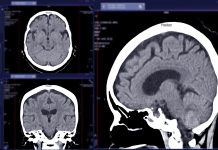A new study investigates how APOE isoforms differentially affect human microglia function in Alzheimer’s disease
Research from Dr Sarah Marzi and Dr Kitty Murphy at the UK DRI at King’s and the Department of Basic and Clinical Neuroscience offers insight into how APOE isoforms differentially affect human microglial function in Alzheimer’s disease, highlighting the need for new targeted interventions based on APOE genotypes.
The study is published today in Nature Communications.
APOE: A major genetic risk factor for Alzheimer’s disease
The apolipoprotein E (APOE) gene is a significant genetic risk factor for Alzheimer’s disease. There are three different versions of the APOE protein: APOE2, APOE3, and APOE4. While APOE4 increases the risk of developing Alzheimer’s, APOE2 is associated with a lower risk. However, the mechanisms by which these different versions lead to strikingly different risk profiles are minimally understood.
The researchers examined APOE in microglia, the brain’s immune cells that are known to play a role in Alzheimer’s disease. As the three versions of APOE are evolutionarily unique to humans, they can’t be directly studied in a mouse brain, posing a challenge to studying them in a laboratory setting.
To overcome this challenge, the researchers developed a human “xenotransplantation model”. Human microglia were grown from stem cells, manipulated to express different APOE versions, and then transplanted into the brains of mice that had developed a buildup of amyloid plaques. The microglia were then isolated and analysed for their gene expression (using a technique called transcriptomics) and for their chromatin accessibility (how accessible the DNA is for genes to be expressed).
The researchers found changes to the transcriptomic and chromatin landscape of microglia, dependent on the APOE isoform expressed. The most significant differences were observed when comparing the APOE2 and APOE4 microglia.
“Our findings emphasise that there is a complex interplay between genetic, epigenetic, and environmental factors that influence microglial responses in Alzheimer’s disease. We found remarkable differences when comparing microglia expressing different isoforms of the same gene,” added Dr Sarah Marzi, Group Leader.
APOE Variants Drive Opposing Microglial Responses
The researchers found that in APOE4 microglia, an increase in the production of cytokines was noted, signalling molecules involved in immune regulation. They also reported diminished capacity for the microglia to migrate and shift into protective states. Furthermore, the microglia became less effective in phagocytosis, a process by which they digest and clear up particles such as debris and pathogens.
Conversely, APOE2 microglia exhibited increased expression of genes that promote microglial proliferation and migration, as well as a decreased inflammatory immune response. Additionally, APOE2 microglia exhibited increased DNA binding of the vitamin D receptor. Low levels of vitamin D have been associated with a higher incidence of Alzheimer’s disease.
The study highlights that microglia responses to amyloid pathology differ significantly across APOE versions. This finding highlights the importance of considering the interplay between genetic risk factors and microglial states in disease progression. The study also highlights the potential role of the vitamin D receptor, providing new avenues for therapeutic exploration.
Dr Marzi said: “Our findings emphasise that there is a complex interplay between genetic, epigenetic, and environmental factors that influence microglial responses in Alzheimer’s disease. We found remarkable differences when comparing microglia expressing different isoforms of the same gene. Our research suggests that microglia expressing the risk-increasing APOE4 variant are less effective at mounting protective microglial functions, including cell migration, phagocytosis, and anti-inflammatory signalling. This underscores the need for targeted interventions based on APOE genotype.”








